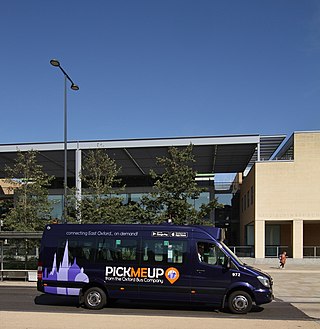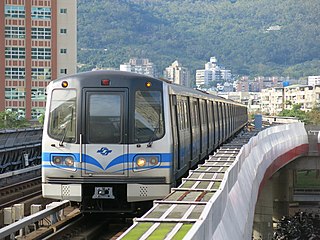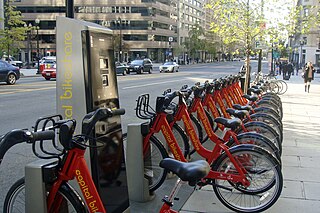Related Research Articles

Private transport is the personal or individual use of transportation which are not available for use by the general public, where in theory the user can decide freely on the time and route of transit, using vehicles such as: private car, company car, bicycle, dicycle, self-balancing scooter, motorcycle, scooter, aircraft, boat, snowmobile, carriage, horse, etc., or recreational equipment such as roller skates, inline skates, sailboat, sailplane, skateboard etc.

Carpooling is the sharing of car journeys so that more than one person travels in a car, and prevents the need for others to have to drive to a location themselves. Carpooling is considered a Demand-Responsive Transport (DRT) service.

Sustainable transport refers to ways of transportation that are sustainable in terms of their social and environmental impacts. Components for evaluating sustainability include the particular vehicles used for road, water or air transport; the source of energy; and the infrastructure used to accommodate the transport. Transport operations and logistics as well as transit-oriented development are also involved in evaluation. Transportation sustainability is largely being measured by transportation system effectiveness and efficiency as well as the environmental and climate impacts of the system. Transport systems have significant impacts on the environment, accounting for between 20% and 25% of world energy consumption and carbon dioxide emissions. The majority of the emissions, almost 97%, came from direct burning of fossil fuels. In 2019, about 95% of the fuel came from fossil sources. The main source of greenhouse gas emissions in the European Union is transportation. In 2019 it contributes to about 31% of global emissions and 24% of emissions in the EU. In addition, up to the COVID-19 pandemic, emissions have only increased in this one sector. Greenhouse gas emissions from transport are increasing at a faster rate than any other energy using sector. Road transport is also a major contributor to local air pollution and smog.

Paratransit or Intermediate Public Transport, is a type of transportation services that supplement fixed-route mass transit by providing individualized rides without fixed routes or timetables. Paratransit services may vary considerably on the degree of flexibility they provide their customers. At their simplest they may consist of a taxi or small bus that will run along a more or less defined route and then stop to pick up or discharge passengers on request. At the other end of the spectrum—fully demand responsive transport—the most flexible paratransit systems offer on-demand call-up door-to-door service from any origin to any destination in a service area. In addition to public transit agencies, paratransit services may be operated by community groups or not-for-profit organizations, and for-profit private companies or operators.

The air taxi market is an application of Advanced Air Mobility (AAM) - air transportation systems that utilize advanced technologies such as vertical takeoffs, autonomous capabilities, or fully-electric systems - for short to mid range on-demand flights. Many AAM vehicles are designed for Short Takeoff and Landing (STOL) or Vertical Takeoff and Landings (VTOL); electric VTOL aircraft are also prominent, known as eVTOLs.

Transportation demand management or travel demand management (TDM) is the application of strategies and policies to increase the efficiency of transportation systems, that reduce travel demand, or to redistribute this demand in space or in time.

Demand-responsive transport (DRT), also known as demand-responsive transit, demand-responsive service, Dial-a-Ride transit, flexible transport services, Microtransit, Non-Emergency Medical Transport (NEMT), Carpool or On-demand bus service is a form of shared private or quasi-public transport for groups traveling where vehicles alter their routes each journey based on particular transport demand without using a fixed route or timetabled journeys. These vehicles typically pick-up and drop-off passengers in locations according to passengers needs and can include taxis, buses or other vehicles. Passengers can typically summon the service with a mobile phone app or by telephone; telephone is particularly relevant to older users who may not be conversant with technology.

The United States is serviced by a wide array of public transportation, including various forms of bus, rail, ferry, and sometimes, airline services. Most established public transit systems are located in central, urban areas where there is enough density and public demand to require public transportation. In more auto-centric suburban localities, public transit is normally, but not always, less frequent and less common. Most public transit services in the United States are either national, regional/commuter, or local, depending on the type of service. Sometimes "public transportation" in the United States is an umbrella term used synonymously with "alternative transportation", meaning any form of mobility that excludes driving alone by automobile. This can sometimes include carpooling, vanpooling, on-demand mobility, infrastructure that is oriented toward bicycles, and paratransit service. There is public transit service in most US cities.

Shared transport or shared mobility is a transportation system where travelers share a vehicle either simultaneously as a group or over time as personal rental, and in the process share the cost of the journey, thus purportedly creating a hybrid between private vehicle use and mass or public transport. It is a transportation strategy that allows users to access transportation services on an as-needed basis. Shared mobility is an umbrella term that encompasses a variety of transportation modes including carsharing, Bicycle-sharing systems, ridesharing companies, carpools, and microtransit.

Public transport is a system of transport for passengers by group travel systems available for use by the general public unlike private transport, typically managed on a schedule, operated on established routes, and that may charge a posted fee for each trip. There is no rigid definition of which kinds of transport are included, and air travel is often not thought of when discussing public transport—dictionaries use wording like "buses, trains, etc." Examples of public transport include city buses, trolleybuses, trams and passenger trains, rapid transit and ferries. Public transport between cities is dominated by airlines, coaches, and intercity rail. High-speed rail networks are being developed in many parts of the world.
PTV Planung Transport Verkehr GmbH is a German company specializing in software and consulting services for traffic and transportation and mobility. Their transport planning software, Vision Traffic Suite comprise the PTV Group's product portfolio. According to the manufacturer; over 2,500 customers in more than 120 countries use the Vision Traffic Suite in the fields of transport modelling and traffic flow calculation. PTV ranks among the top 1,000 global market leaders in Germany according to Germany's Manager Magazine.

In supply chain management and transportation planning, the last mile or last kilometer is the last leg of a journey comprising the movement of passengers and goods from a transportation hub to a final destination. The concept of "last mile" was adopted from the telecommunications industry, which faced difficulty connecting individual homes to the main telecommunications network. Similarly, in supply chain management, last-mile describes the logistical challenges at the last phase of transportation getting people and packages from hubs to their final destinations.
Moovit is an Israel-based mobility as a service provider and journey planner app. It is owned by Mobileye, and was acquired by Intel in 2020 until Mobileye's IPO in 2022. Moovit uses both crowdsourced and official public transit data to provide route planning to users as well as transit data APIs to transit companies, cities, and transit agencies. Because Moovit integrates crowdsourced data, it can provide transit information for areas where no data is officially available.
A robotaxi, also known as robot taxi, robo-taxi, self-driving taxi or driverless taxi, is an autonomous car operated for a ridesharing company.

Bolt is an Estonian mobility company that offers ride-hailing, micromobility rental, food and grocery delivery, and carsharing services. The company is headquartered in Tallinn and operates in over 500 cities in more than 45 countries in Europe, Africa, Western Asia and Latin America. The company has more than 150 million customers and more than 3 million driver and courier partners. The company has plans for an initial public offering in 2025.
BRIDJ is a SaaS platform designed to support 'demand responsive' or 'on demand' public transport providers. The platform allows a user to optimise an on-road service and digitise work processes, and includes an optimisation engine, traveller app, driver app and client portal. The traveller app allows passengers to book, pay and track a service between two locations within a service area. The optimisation engine consumes pre-planned and real-time bookings and then allocates passengers to the available vehicles to create the optimal trips for the given service objectives. The optimisation engine is designed to handle large numbers of passengers and vehicles of both small capacities and high capacity (6-50+). BRIDJ technology is currently deployed on public transport services in both Sydney and Adelaide, Australia and for transfer services Singapore.

Via Transportation, Inc. provides software as a service (SaaS) and mobility as a service to operators of public transportation, multimodal transport, paratransit operations in compliance with laws such as the Americans with Disabilities Act of 1990, non-emergency medical transportation, logistics and deliveries, school bus fleets, commercial ridesharing and corporate shuttles, and autonomous vehicles. Its customers include cities, transportation authorities, government entities, school districts, universities, and private organizations worldwide. It was founded in 2012 and is headquartered in New York City.

Microtransit is a form of bus demand responsive transport vehicle for hire. This transit service offers a highly flexible routing and/or highly flexible scheduling of minibus vehicles shared with other passengers. Microtransit providers build routes ad-hoc exclusively to match only each demand (trip) and supply and to extend the efficiency and accessibility of the transit service. Possible pick-up/drop-off stops are restricted, and transit can be provided as a stop-to-stop service or a curb-to-curb service.
Smart mobility refers to many modes of transport.
Autonomous mobility on demand (AMoD) is a service consisting of a fleet of autonomous vehicles used for one-way passenger mobility. An AMoD fleet operates in a specific and limited environment, such as a city or a rural area.
References
- ↑ Smith, Göran. "Making Mobility-as-a-Service: Towards Governance Principles and Pathways" . Retrieved 2020-09-25.
- ↑ Mladenović, Miloš N. (2021). "Mobility as a Service". International Encyclopedia of Transportation. pp. 12–18. doi:10.1016/B978-0-08-102671-7.10607-4. ISBN 978-0-08-102672-4. S2CID 242133419.
- ↑ "Global Intelligent Transportation Systems Market to Grow at a CAGR of over 10% Through 2020 Finds TechSci Research" (Press release). TechSci Research. 18 January 2016.
- ↑ Hamid, Umar Zakir Abdul; Al-Turjman, Fadi (2021). "Introductory Chapter: A Brief Overview of Autonomous, Connected, Electric and Shared (ACES) Vehicles as the Future of Mobility". Towards Connected and Autonomous Vehicle Highways. EAI/Springer Innovations in Communication and Computing. pp. 3–8. doi:10.1007/978-3-030-66042-0_1. ISBN 978-3-030-66041-3. S2CID 238013009.
- ↑ Kamargianni, Maria. "Feasibility Study for Mobility as a Service Concept for London" (PDF). Retrieved Jun 1, 2015.
- ↑ "NextCity: Cubic's Vision for the Future of Urban Mobility". www.cubic.com. 2014-10-21. Archived from the original on 2017-08-03. Retrieved 2016-02-29.
- ↑ Hasselwander, Marc; Bigotte, Joao F. (2023-09-05). "Mobility as a Service (MaaS) in the Global South: research findings, gaps, and directions". European Transport Research Review. 15 (1): 27. Bibcode:2023ETRR...15...27H. doi: 10.1186/s12544-023-00604-2 . hdl: 10316/111615 . ISSN 1866-8887.
- 1 2 3 Taiebat; Brown; Safford; Qu; Xu (2018). "A Review on Energy, Environmental, and Sustainability Implications of Connected and Automated Vehicles". Environmental Science & Technology. 52 (20): 11449–11465. arXiv: 1901.10581 . doi:10.1021/acs.est.8b00127. PMID 30192527. S2CID 52174043.
- ↑ "Car Emissions and Global Warming". Union of Concerned Scientists. Retrieved 2016-02-29.
- ↑ Pangbourne, Kate; Mladenović, Miloš N.; Stead, Dominic; Milakis, Dimitris (January 2020). "Questioning mobility as a service: Unanticipated implications for society and governance". Transportation Research Part A: Policy and Practice. 131: 35–49. doi: 10.1016/j.tra.2019.09.033 . S2CID 181893706.
- ↑ Mladenović, Miloš N.; Haavisto, Noora (June 2021). "Interpretative flexibility and conflicts in the emergence of Mobility as a Service: Finnish public sector actor perspectives". Case Studies on Transport Policy. 9 (2): 851–859. doi: 10.1016/j.cstp.2021.04.005 . S2CID 234851464.
- ↑ Dzisi, Emmanuel; Obeng, Daniel Atuah; Tuffour, Yaw Adubofour (May 2021). "Modifying the SERVPERF to assess paratransit minibus taxis trotro in Ghana and the relevance of mobility-as-a-service features to the service". Heliyon. 7 (5): e07071. Bibcode:2021Heliy...707071D. doi: 10.1016/j.heliyon.2021.e07071 . PMC 8176316 . PMID 34136679.
- ↑ Dzisi, Emmanuel Komla Junior; Obeng, Daniel Atuah; Ackaah, Williams; Tuffour, Yaw Adubofour (1 January 2022). "MaaS for paratransit minibus taxis in developing countries: A review". Travel Behaviour and Society. 26: 18–27. doi:10.1016/j.tbs.2021.09.001. S2CID 239334558.
- ↑ "Bicycle, Car & CarSharing". www.gvh.de. Retrieved 2016-02-29.
- ↑ "Home page". Oct 10, 2015. Archived from the original on October 23, 2018. Retrieved August 16, 2018.
- ↑ "Company web page". Oct 10, 2015. Archived from the original on March 5, 2016. Retrieved August 16, 2018.
- ↑ "Uber CEO explains his company's highly ambitious goal to end car ownership in the world". Business Insider Australia. 8 February 2015. Archived from the original on 2015-11-01. Retrieved 2015-11-02.
- ↑ Rubalcava, Alex (2015-08-26). "A Roadmap for a World Without Drivers". Alex Rubalcava. Retrieved 2017-12-11.
- ↑ "Driving Forward - What's Beyond Self-Driving Cars? | TechWeekEurope UK". TechWeekEurope UK. Retrieved 2016-02-29.
- ↑ Urban Mobility System Upgrade: How shared self-driving cars could change city traffic (PDF). International Transport Forum's Corporate Partnership Board. 2015.
- ↑ Wagstaff, Keith (14 January 2016). "Obama Administration Unveils $4B Plan to Jump-Start Self-Driving Cars". NBC News. Retrieved 21 July 2016.
- ↑ Tschanz, Nico; Zimmermann, Hans-Dieter (1996). "The Electronic Mall Bodensee as Platform for the Development of Travel Services". Information and Communication Technologies in Tourism. pp. 200–210. doi:10.1007/978-3-7091-7598-9_23. ISBN 978-3-211-82798-7.
- ↑ "Ubigo home page (Swedish)". Oct 10, 2015.
- ↑ "E-Mobility as a Service (Half Day Conference)". June 26, 2012. Retrieved December 14, 2021.
- ↑ "Mobility as a Service - A Proposal for Action for the Public Administration, Case Helsinki". Oct 10, 2015. Archived from the original on May 24, 2016. Retrieved August 16, 2018.
- ↑ "Mobility as a Service – the new transport paradigm". Oct 10, 2015. Archived from the original on August 5, 2017. Retrieved August 16, 2018.
- ↑ "Launch of MaaS Alliance". October 10, 2015.[ permanent dead link ]
- ↑ "White Paper: Mobility as a Service (MaaS)" (PDF). MaaS Alliance. Brussels. September 4, 2019. Retrieved December 14, 2021.
- ↑ "Mobinet home page". Oct 10, 2015.
- ↑ Busvine, Douglas (Sep 24, 2019). "From U-Bahn to e-scooters: Berlin mobility app has it all". Reuters.
- ↑ "U.S. DOT Secretary Foxx Participates in White House Frontiers Conference, Announces Nearly $65 Million in Advanced Technology Transportation Grants | FTA". www.transit.dot.gov. Retrieved 2022-10-20.
- 1 2 "Mobility on Demand (MOD) Sandbox Program | FTA". www.transit.dot.gov. Retrieved 2022-10-20.
- 1 2 McGinnis, James; McLaughlin, Preston (2022-01-01). Mobility on Demand Sandbox Demonstration: Adaptive Mobility with Reliability and Efficiency (AMORE), Final Report (Report). doi:10.21949/1520693.
- ↑ Sheyner, Gennady. "Palo Alto prepares to enter 'microtransit' arena with on-demand shuttles". paloaltoonline.com. Retrieved 2022-10-20.
- 1 2 "Mobility on Demand (MOD) Sandbox Demonstration: Puget Sound First/Last Mile Partnership with Via (Report 0183) | FTA". www.transit.dot.gov. Retrieved 2022-10-20.
- ↑ Audouin, Maxime; Finger, Matthias (2019). "Empower or Thwart? Insights from Vienna and Helsinki regarding the role of public authorities in the development of MaaS schemes". Transportation Research Procedia. 41: 6–16. doi: 10.1016/j.trpro.2019.09.003 .
- ↑ "SMILE Project in Vienna | TRANSFORM". 2018-09-14. Archived from the original on 2018-09-14. Retrieved 2023-12-12.
- ↑ Carey, Christopher (2023-09-11). "Brussels launches new MaaS app". Cities Today. Retrieved 2023-12-11.
- ↑ "Moving MaaS 3: Helsinki Happenings – The Eno Center for Transportation". 2023-12-07. Retrieved 2023-12-12.
- ↑ "Bahn verkauft Qixxit an Lastminute » MOViNC.de". MOViNC (in German). 2019-07-03. Retrieved 2023-12-11.
- ↑ Braams, Rik B.; Wesseling, Joeri H.; Meijer, Albert J.; Hekkert, Marko P. (2023-05-11). "Civil servant tactics for realizing transition tasks understanding the microdynamics of transformative government". Public Administration. doi: 10.1111/padm.12933 . ISSN 0033-3298.
- ↑ Frost, Adam (2019-05-07). "New MaaS travel service launches in Stockholm". Traffic Technology Today. Retrieved 2023-12-12.
- ↑ Carey, Christopher (2023-07-07). "West Midlands gives MaaS another go". Cities Today. Retrieved 2023-12-11.
- ↑ Badzmierowski, Brian. "Go Denver App: Will It Help Find Better, Cheaper, Faster Ways to Get Around?". Westword. Retrieved 2023-12-12.
- ↑ "Go Denver opens up a world of seamless mobility and better data-driven decisions". ITS International. Retrieved 2023-12-12.
- ↑ "Moving MaaS: Mobility as a Service in the United States and Abroad – The Eno Center for Transportation". 2023-12-07. Retrieved 2023-12-11.
- ↑ "Move PGH". Engage Pittsburgh. Retrieved 2023-12-11.
- ↑ Carey, Christopher (2022-12-12). "Florida city trials mobility-as-a-service app". Cities Today. Retrieved 2023-12-14.
- ↑ "City of Tampa Launches Mobility as a Service (MaaS) App | City of Tampa". www.tampa.gov. 2022-12-12. Retrieved 2023-12-14.